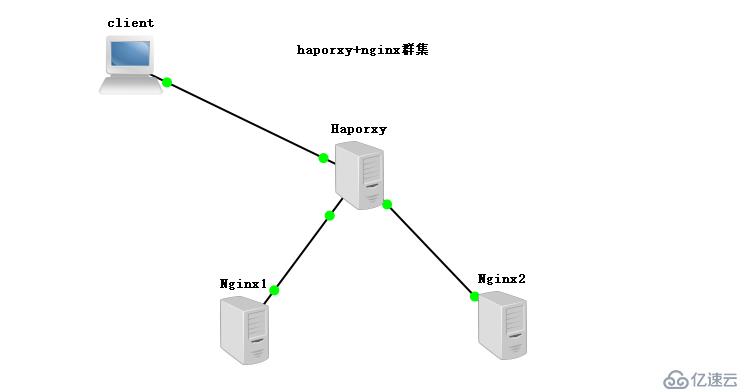溫馨提示×
您好,登錄后才能下訂單哦!
點擊 登錄注冊 即表示同意《億速云用戶服務條款》
您好,登錄后才能下訂單哦!
目前常見的web集群調度器分為軟件和硬件,軟件通常使用開源的LVS,Haproxy,Nginx,硬件一般使用比較多的是F5,也有很多人使用國內的一些產品,如梭子魚,綠盟等
LVS不支持正則處理,不能實現動靜分離
對于大型網站,LVS的實施配置復雜,維護成本相對較高特別適用于負載特別大的web站點
運行在當前的硬件上可支持數以萬計的并發連接連接請求RR:最簡單常用的,輪詢調度
LC:最小連接數算法,根據后端的節點連接數大小動態分配前端請求
SH:來源訪問調度算法,用于有session會話記錄在服務器端,可以基于來源ip,cookie做群集調度
Haporxy服務器 192.168.13.175
web1服務器 192.168.13.151
web2服務器 192.168.13.176
client測試機[root@web1 ~]# yum install -y \ ##安裝環境需要組件包
> pcre-devel \ ##開發包
> zlib-devel \ ##壓縮包
> gcc \
> gcc-c++ \
> make
[root@web1 ~]# useradd -M -s /sbin/nologin nginx ##創建系統用戶
[root@web1 ~]# mkdir /abc ##創建掛載點
[root@web1 ~]# mount.cifs //192.168.100.3/LNMP-C7 /abc/ ##掛載
Password for root@//192.168.100.3/LNMP-C7:
[root@web1 ~]# cd /abc/
[root@web1 abc]# tar zxvf nginx-1.12.2.tar.gz -C /opt ##解壓
[root@web1 abc]# cd /opt/nginx-1.12.2/
[root@web1 nginx-1.12.2]# ./configure \ ##進行配置
> --prefix=/usr/local/nginx \
> --user=nginx \
> --group=nginx
[root@web1 nginx-1.12.2]# make && make install
[root@web1 nginx-1.12.2]# echo "this is kgv web" > /usr/local/nginx/html/test.html
##創建站點網頁內容,web2上為this is accp web
[root@web1 nginx-1.12.2]# ln -s /usr/local/nginx/sbin/nginx /usr/local/sbin/ ##便于系統識別
[root@web1 nginx-1.12.2]# nginx -t ##檢查語法
[root@web1 nginx-1.12.2]# nginx ##開啟服務
[root@web1 nginx-1.12.2]# systemctl stop firewalld.service ##關閉防火墻
[root@web1 nginx-1.12.2]# setenforce 0[root@haproxy ~]# yum install -y \ ##安裝環境組件工具
> pcre-devel \
> bzip2-devel \
> gcc \
> gcc-c++ \
> make
[root@haproxy ~]# systemctl stop firewalld.service ##關閉防火墻
[root@haproxy ~]# setenforce 0
[root@haproxy ~]# mkdir /abc
[root@haproxy ~]# mount.cifs //192.168.100.3/LNMP-C7 /abc/ ##掛載
[root@haproxy ~]# cd /abc/
[root@haproxy abc]# tar zxvf haproxy-1.5.19.tar.gz -C /opt/ ##解壓
[root@haproxy abc]# cd /opt/haproxy-1.5.19/
[root@haproxy haproxy-1.5.19]# make TARGET=linux26 ##編譯
[root@haproxy haproxy-1.5.19]# make install ##安裝
[root@haproxy haproxy-1.5.19]# mkdir /etc/haproxy ##創建配置文件目錄
[root@haproxy haproxy-1.5.19]# cp examples/haproxy.cfg /etc/haproxy/ ##模板復制到配置目錄下
[root@haproxy haproxy-1.5.19]# cd /etc/haproxy/
[root@haproxy haproxy]# vim haproxy.cfg ##編輯配置文件
----------刪除所有listen項目,并添加------------------------------------
注釋以下語句
chroot /usr/share/haproxy
redispatch
添加
listen webcluster 0.0.0.0:80
option httpchk GET /test.html ##web網頁
balance roundrobin ##輪詢
server inst1 192.168.13.151:80 check inter 2000 fall 3 ##健康檢查請求三次
server inst2 192.168.13.176:80 check inter 2000 fall 3
[root@haproxy haproxy]# cp /opt/haproxy-1.5.19/examples/haproxy.init /etc/init.d/haproxy ##啟動文件
[root@haproxy haproxy]# chmod +x /etc/init.d/haproxy ##執行權限
[root@haproxy haproxy]# chkconfig --add /etc/init.d/haproxy ##添加到service
[root@haproxy haproxy]# ln -s /usr/local/sbin/haproxy /usr/sbin/ ##便于系統識別
[root@haproxy haproxy]# service haproxy start ##開啟服務
Starting haproxy (via systemctl): [ 確定 ]
[root@haproxy haproxy]# netstat -ntap | grep haproxy ##查看端口
tcp 0 0 0.0.0.0:80 0.0.0.0:* LISTEN 39884/haproxy 

[root@haproxy haproxy]# vim /etc/haproxy/haproxy.cfg ##修改配置文件
global
log /dev/log local0 info ##添加兩個級別的日志文件
log /dev/log local0 notice
#log loghost local0 info
[root@haproxy haproxy]# service haproxy restart ##重啟服務
[root@haproxy haproxy]# touch /etc/rsyslog.d/haproxy.conf ##創建系統日志haproxy配置文件
[root@haproxy haproxy]# vim /etc/rsyslog.d/haproxy.conf
if ($programname == 'haproxy' and $syslogseverity-text == 'info') ##根據級別創建不同的日志文件
then -/var/log/haproxy/haproxy-info.log
&~
if ($programname == 'haproxy' and $syslogseverity-text == 'notice')
then -/var/log/haproxy/haproxy-notice.log
&~
[root@haproxy haproxy]# systemctl restart rsyslog.service ##重啟系統日志服務
[root@haproxy haproxy]# cd /var/log/ ##此時是沒有haproxy日志
##重新訪問網頁
[root@haproxy haproxy]# cd /var/log/haproxy/
[root@haproxy haproxy]# ls ##此時就生成了info級別的日志文件
haproxy-info.log免責聲明:本站發布的內容(圖片、視頻和文字)以原創、轉載和分享為主,文章觀點不代表本網站立場,如果涉及侵權請聯系站長郵箱:is@yisu.com進行舉報,并提供相關證據,一經查實,將立刻刪除涉嫌侵權內容。